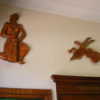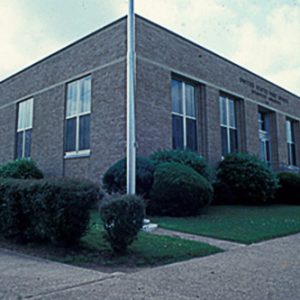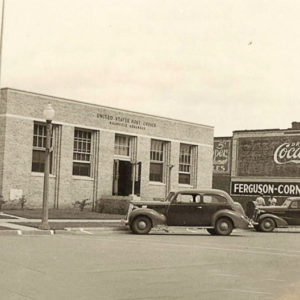calsfoundation@cals.org
Nashville Post Office
The Nashville Post Office in Nashville (Howard County) is a single-story, brick-masonry structure designed in a restrained interpretation of the Art Deco style of architecture and featuring a mural created through the U.S. Treasury Department’s Section of Painting and Sculpture (later renamed the Section of Fine Arts), a Depression-era stimulus project that promoted public art. The post office was listed on the National Register of Historic Places on August 14, 1998.
On June 26, 1936, the Nashville News reported that the Howard County seat of Nashville was selected as the site of a new U.S. Post Office facility under a $60 million federal emergency construction program. Site proposals were requested four days later, and on September 18, the News reported that the J. R. Hill lots on North Main Street were tentatively selected at a purchase price of $10,000. The proposal was formally accepted in October, but it was not until June 8, 1937, that the deal was closed. The Algernon Blair construction company of Montgomery, Alabama, was the winning contractor with a bid of $40,793. The building’s grand opening was held on January 11, 1938.
Included in the original specifications for the Nashville Post Office was a $660 line item for a mural for the new building. In August 1938, Edward B. Rowan, superintendent of the U.S. Treasury Department’s Section of Painting and Sculpture, invited John Tazewell Robertson of Millington, New Jersey, to submit designs for the project. Robertson enthusiastically responded on August 26, proposing to use the legend of “The Arkansas Traveler” as the basis for his mural. However, the artist later wrote that Postmaster Roy Milwee “replied that he felt the people of Nashville would much prefer something to do with the Peach Industry (which it seems is the most important business in that section).” The formal contract was prepared on November 15, 1938. In making the corrections for his color sketch, Robertson noted that Postmaster Milwee requested that the artist incorporate an image of the late Bert Johnson, “who it seems was the father of the peach industry in Arkansas,” into the mural.
On May 19, 1939, Robertson submitted a photograph of a full-sized cartoon of the Nashville mural. His explanation of the delay in the project is illustrative of the hectic life of an artist in the Great Depression: “I had expected to have this finished long before this but some months ago I lost my W.P.A. job on the Board of Education illustrations project (not being a Union member) and have been obliged in the meantime to scramble around with some free lance work.”
Coincidentally, Robertson ran into artist Ludwig Mactarian in New York in late June and learned that Mactarian was completing a mural for the Dardanelle Post Office. Ever mindful of finances, Robertson wrote Rowan on June 30 that he and Mactarian “discussed the angle of going down together to make installation on the two jobs which would eliminate the necessity of employing unskilled labor to assist” as well as offering them an opportunity to visit other post offices along the way with an eye on submitting designs for the Section’s upcoming 48 States Competition.
The mural was installed in late July, and the journey was a good one for Robertson. “At last it’s up,” he wrote Rowan on July 26. “We arrived here two days ago and everyone has been perfectly marvelous to us from the Postmaster on down. Our experience here and the reaction of the people to the work has compensated more than anything for the work I have done on this.” Robertson’s mural was well received in Nashville. An undated clipping from the News found it “most appropriate and fitting by the artist that a portrait of the late Bert Johnson was incorporated into the design as a memorial to the man who was instrumental in the development of this section as a peach country.”
The Section approved Robertson’s final payment on August 17, 1939. His mural Peach Growing remains the focal point of the Nashville Post Office in the twenty-first century. The building continues to serve as Nashville’s post office and has not been significantly altered since construction.
For additional information:
“Arkansas Post Office Murals.” University of Central Arkansas. http://uca.edu/postofficemurals/home/ (accessed September 7, 2021).
Arkansas Post Office Murals Records. Arkansas State Archives, Little Rock, Arkansas.
“Construction of Post Office Begins Monday.” Nashville News, July 30, 1937, p. 1.
“Nashville Post Office.” National Register of Historic Places nomination form. On file at Arkansas Historic Preservation Program, Little Rock, Arkansas.
“Nashville to Get Post Office Building in Group Authorized by Treasury Dept.” Nashville News, June 26, 1936, p. 1.
“Nashville’s New Post Office Put into Use.” Nashville News, January 11, 1937, p. 1.
“Order Issued for Building of Post Office.” Nashville News, July 13, 1937, p. 1.
“Post Office Site Formally Accepted.” Nashville News, October 13, 1936, p. 1.
“Post Office to Move into New Building Soon.” Nashville News, December 31, 1937, p. 1.
“Site Chosen for Post Office in Nashville.” Nashville News, September 16, 1936, p. 1.
Smith, Sandra Taylor, and Mark K. Christ. Arkansas Post Offices and the Treasury Department’s Section Art Program, 1938–1942. Little Rock: Arkansas Historic Preservation Program, 1998. Online at http://www.arkansaspreservation.com/News-and-Events/publications (accessed September 7, 2021).
 Early Twentieth Century, 1901 through 1940
Early Twentieth Century, 1901 through 1940 Historic Preservation
Historic Preservation Post Office Art
Post Office Art Nashville Post Office
Nashville Post Office  Nashville Post Office
Nashville Post Office 




Comments
No comments on this entry yet.